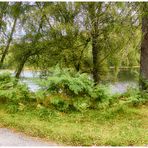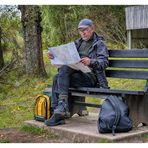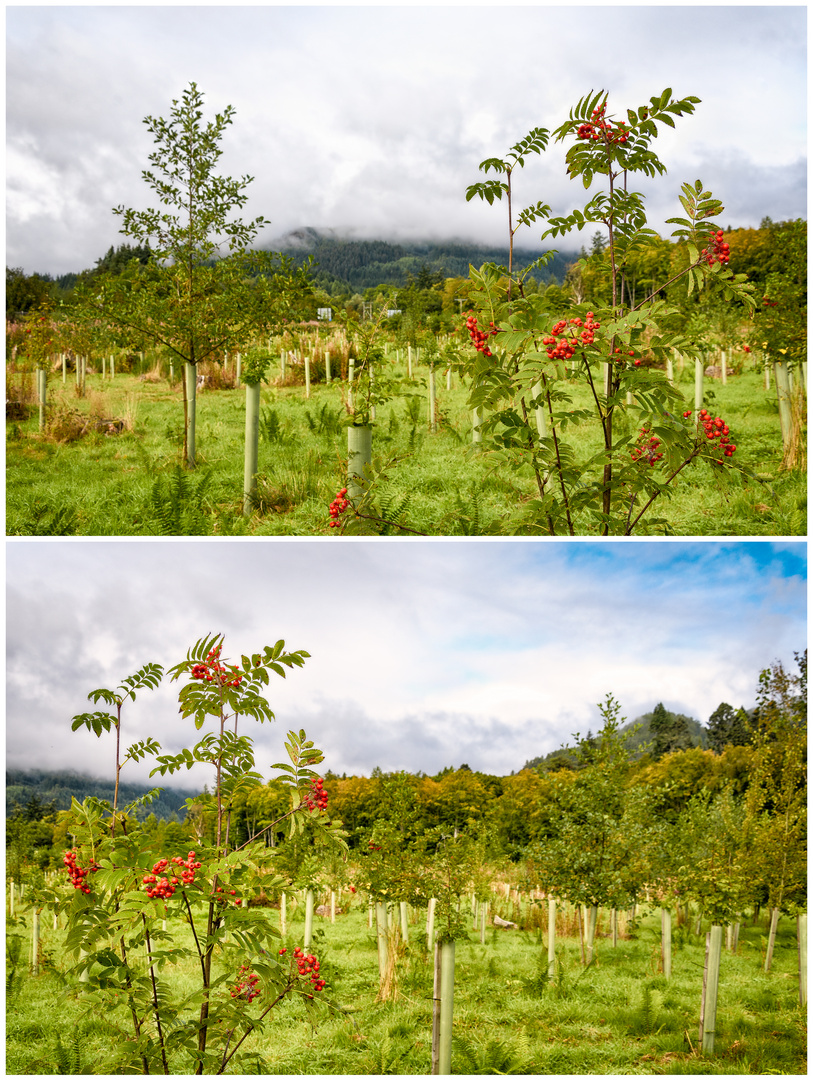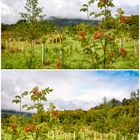Reforestation at River Tay
09/19/2022
After a quiet Sunday, Gordon and I went for a walk along the River Tay on Monday. First we went past an operations center and a tennis club, west under the A9 and immediately onto a bridge over the small river Braan, before changing again under the A9 to Path on the Tay. The path leads past a reforestation area where rowan trees also grow. The red berries stood out from the green surroundings and I decided to take two snapshots; especially as the low-hanging clouds crept over the wooded hills in the background. In the east the cloud cover cleared and the first patch of blue sky appeared. Perfect hiking weather.
Place of Reforestation: https://maps.app.goo.gl/nMi6i72mEQpsB9ND7
Rowan (Sorbus aucuparia):
Location: sunny to partially shaded
Soil: permeable, fresh
Fruits: medium-sized, round fruits grouped into large umbels, often orange to red in color
Leaves: deciduous, gray-green color
Rowan is now also available as a cultivated form, which is even better tolerated than wild forms. The fruits must be cooked before consumption. Cultivated forms also have the advantage that they are significantly more productive than the wild forms, which are very popular with birds.
"Afforestation efforts in Scotland have provided an increase in woodland expansion. By the 20th century mark, Scotland had diminished woodland coverage to 5% of Scotland's land area. However, by the early 21st century, afforestation efforts have increased woodland coverage to 17%. The Scottish government released their Draft Climate Change Plan in January 2017. The 2017 draft plan has increased the targeted woodland coverage to 21% by 2032 and increases the afforestation rate to 15,000 hectares per year."
https://en.m.wikipedia.org/wiki/Afforestation_in_Scotland
Aufforstungsgebiet am Fluss Tay
19.09.2022
Nach einem ruhigen Sonntag unternahmen Gordon und ich montags eine Wanderung am Fluß Tay entlang. Zuerst ging es, an einem Operationszentrum und einem Tennisklub vorbei, westlich unter der A9 hindurch und sofort auf eine Brücke über den kleinen Fluss Braan, um erneut unter der A9 wieder zu Pfad am Tay zu wechseln. Dabei führt der Weg an einem Aufforstungsgebiet vorbei, auf dem auch Ebereschen wachsen. Die roten Beeren leuchteten aus der grünen Umgebung heraus und ich entschied mich kurz zwei Schnappschüsse zu machen; zumal im Hintergrund die tiefhängenden Wolken über die bewaldeten Hügel krochen. Im Osten riss die Wolkendecke auf und das erste Flecken blauen Himmels liess sich blicken. Perfektes Wanderwetter.
Ort des Aufforstungsgebiets: https://maps.app.goo.gl/nMi6i72mEQpsB9ND7
Eberesche (Sorbus aucuparia):
Standort: sonnig bis halbschattig
Boden: durchlässig, frisch
Früchte: mittelgroße runde Früchte zu großen Scheindolden zusammengefasst, oft orange bis rote Farbe
Blätter: laubabwerfend, graugrüne Farbe
Die Eberesche gibt es mittlerweile auch als Kulturform, die sogar besser verträglich ist als Wildformen. Für den Verzehr müssen die Früchte zwingend gekocht werden. Kulturformen haben zudem den Vorteil, dass sie deutlich ertragreicher sind, als die Wildformen, die bei Vögeln sehr beliebt sind.
https://www.gartendialog.de/baeume-straeucher-rote-beeren/
„Aufforstungsbemühungen in Schottland haben zu einem Anstieg der Waldausdehnung geführt. Bis zum 20. Jahrhundert hatte Schottland die Waldfläche auf 5 % der schottischen Landfläche verringert. Zu Beginn des 21. Jahrhunderts stieg die Waldfläche jedoch durch Aufforstungsbemühungen auf 17 %.“ Die schottische Regierung hat im Januar 2017 ihren Entwurf eines Klimaschutzplans veröffentlicht. Der Planentwurf von 2017 hat die angestrebte Waldfläche bis 2032 auf 21 % erhöht und die Aufforstungsrate auf 15.000 Hektar pro Jahr erhöht.“

Tathajam Concert
Manuel Gloger

Mill Dam Panorama
Manuel Gloger

Gordon studies the walking map
Manuel Gloger












Vitória Castelo Santos 18/09/2023 15:59
Ein sehr, sehr schönes Fotocollage.!!LG Vitoria
Joachim Irelandeddie 18/09/2023 7:03
Eine sehr schöne Aufnahme die du hier von der Aufforstung gemacht hast Deine ausführliche Beschreibung ist auch wieder sehr gut zu lesen.LG eddie
Stefan Jo Fuchs 18/09/2023 6:50
Schön, diese Maßnahmen der Schotten so beobachten zu können.Und auch wenn das karge, waldlose der Highlands oft den landschaftlichen Reiz des wilden Schottland ausmacht, sind diese Vorhaben natürlich nur zu begrüßen - schließlich war es mal der Normalzustand, bevor der Mensch massiv eingriff.
lg stefan